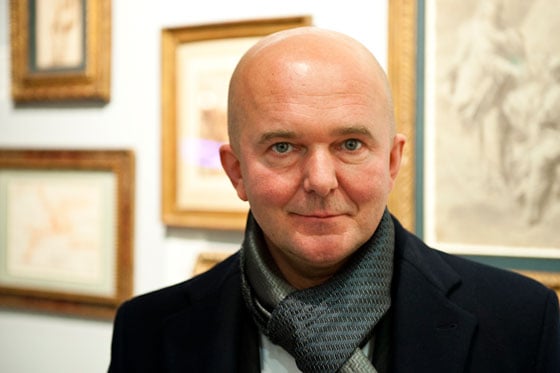
Photo: Artnet.
Art Cologne 2015.
Photo: Koelnmesse.
Germany has one of the liveliest and most eclectic collector communities in the world. As Europe’s largest economy and most populous country, there’s a large number of art patrons with money to spend.
Art Cologne, the world’s oldest and most important art fair, kicks off today with its press preview and vernissage. In honor of the opening, we took a look at the top 10 German art collectors. Those that made the list were chosen for their innovative approach, and the overall size and significance of their respective collections.
Frieder Burda.
Photo: Courtesy of Joe Schildhorn/ Patrick McMullan.
1. Frieder Burda
As the son of a renowned German publisher and collector, continuing his family collection came naturally for Frieder Burda. He bought his first artwork in his early 30s—a Lucio Fontana, no less. In 2004 he opened the Frieder Burda Museum in Baden-Baden to house his growing collection of German Expressionism, Abstract Expressionism and German contemporary stars including Sigmar Polke, Georg Baselitz and Gerhard Richter.
Nicolas Berggruen.
Photo: Paul Bruinooge/PatrickMcMullan.
2. Nicolas Berggruen
The philanthropist and investor is the son of the renowned collector Heinz Berggruen. Unlike his father, who had a penchant for modern masters, Nicolas prefers contemporary American artists such as Ed Ruscha, Paul McCarthy, Bruce Nauman, and Mike Kelley; as well as German artists including Gerhard Richter, Sigmar Polke, and Martin Kippenberger. Ironically for someone who spends so much on art, he can’t display most of his acquisitions because he doesn’t own a home. Known as the “homeless billionaire,” Berggruen lives in hotels.
Berlin based collector and publisher Christian Boros and his wife Karen.
Photo: JOHN MACDOUGALL/AFP/GettyImages.
3. Christian and Karen Boros
The ad agency scion and publisher Christian Boros is perhaps better known for the extraordinary building housing his collection, rather than its contents. His collection is displayed in a repurposed air-raid bunker in the middle of Berlin. The 80-room private museum includes works by contemporary artists such as Elmgreen & Dragset, Alicja Kwade, Michael Sailstorfer, Klara Liden, and Ai Weiwei. Boros and his wife Karen live in a glass apartment built on the roof of the bunker.
German billionaire industrialist and art collector Reinhold Wuerth.
Photo: ODD ANDERSEN/AFP/Getty Images.
4. Reinhold Würth
Founder of the Würth Group, an international wholesaler of screws, screw fasteners, dowels, chemicals and other construction equipment, Reinhold Würth spent a large part of his fortune on art. His collection includes everything from contemporary art by the likes of Roy Lichtenstein, Georg Baselitz, and Gerhard Richter to Expressionists such as Ernst Ludwig Kirchner, Emil Nolde, and Max Beckmann and German Renaissance paintings by the likes of Hans Holbein—Although the earlier works in his collection are significantly better quality than his more contemporary pieces. His collection was recently the subject of a major museum show at Berlin’s Martin Gropius Bau.
Désiré Feuerle.
Photo: Mark G. Peters via The Feuerle Collection.
5. Desire Feuerle
A former art dealer and collector of international contemporary and Southeast Asian art and imperial Chinese design, Desire Feuerle is among the more eclectic German collectors. His collection spans 7th–13th century Khmer sculptures in stone, bronze, and wood, as well as imperial Chinese furniture dating from the Han to the Qing dynasties (200 BC—18th century) and contemporary works by the likes of Cristina Iglesias, Anish Kapoor, Zeng Fanzhi, and James Lee Byars.
Hasso Plattner.
Photo: Wikimedia Commons.
6. Hasso Plattner
Co-founder of the software giant SAP, Hasso Plattner is a major collector of important Impressionist and modern artworks. His holdings include Pierre-Auguste Renoir, Claude Monet, Edvard Munch, and Emil Nolde. The billionaire is currently funding the construction of a replica of Potsdam’s 18th century Barberini Palace, which was destroyed during World War II. Scheduled to open in 2017, the Barberini Museum will house 250 works from Plattner’s collection, which he has already pledged to bequeath to the German state.
Harald Falckenberg.
Photo: via Wikimedia Commons.
7. Harald Falckenberg
The Hamburg-based collector Harald Falckenberg has developed a reputation for acquiring works by important artists ahead of the market. He was one of the first buyers of Martin Kippenberger, Richard Prince, and Jonathan Meese. His patronage of the arts earned him the Art Cologne Prize in 2009, and the Montblanc de la Culture Arts Patronage Award in 2011. Falckenberg’s 2,000-piece collection is shown in a 65,000-square-foot former factory building in Hamburg, in collaboration with Deichtorhallen.
Mick Flick with art dealer David Zwirner.
Photo: artnet Magazine.
8. Friedrich Christian (Mick) Flick
An heir to the Weimar-era Flick industrial fortune, Mick Flick’s collection of contemporary art includes works by Cindy Sherman, Thomas Struth, Jason Rhodes, Katharina Fritsch and Manfred Pernice. Flick has a strong philanthropic association with Berlin’s Hamburger Bahnhof Museum for Contemporary Art, which he gifted over 200 pieces of contemporary art in 2008 and 2015.
Julia Stoschek.
Photo: Courtesy of Billy Farrell/Patrick McMullan.
9. Julia Stoschek
Julia Stoschek, a collector of media and video art, is the daughter of Michael Stoschek, a billionaire businessman and chairman of Brose Farzeugteile, a car-parts company founded by her great-grandfather Max Brose. The arts philanthropist displays her collection at the Düsseldorf-based Julia Stoschek Collection, a private museum which includes works by established artist such as Bruce Nauman and up-and-comers like Clemens von Wedemeyer. She recently announced the creation of a second exhibition space, which will open in Berlin’s Mitte district ahead of the 9th Berlin Biennale in June.
Ingvild Goetz: Owner of the internationally renowned Goetz Collection.
Photo: Courtesy Sammlung Goetz.
10. Ingvild Goetz
Former gallerist Ingvild Goetz started collecting painting, sculpture, and works on paper in 1984. Today, her extraordinarily large collection contains nearly 5,000 works including over 500 video and media works, housed in a private museum designed by Herzog & de Meuron in Munich. Much of the collection is composed of works by emerging contemporary artists, and nearly half of the artworks in her collection are created by women.